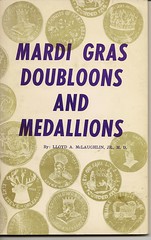
About UsThe Numismatic Bibliomania Society is a non-profit organization promoting numismatic literature. For more information please see our web site at coinbooks.org SubscriptionsThose wishing to become new E-Sylum subscribers (or wishing to Unsubscribe) can go to the following web page link MembershipThere is a membership application available on the web site Membership Application To join, print the application and return it with your check to the address printed on the application. Membership is only $15 to addresses in the U.S., $20 for First Class mail, and $25 elsewhere. For those without web access, write to: David M. Sundman, Secretary/TreasurerNumismatic Bibliomania
Society AsylumFor Asylum mailing address changes and other membership questions, contact David at this email address: dsundman@LittletonCoin.com SubmissionsTo submit items for publication in The E-Sylum, just Reply to this message, or write to the Editor at this address: whomren@coinlibrary.com
BUY THE BOOK BEFORE THE COINYou won't regret it! |
- WAYNE'S WORDS: THE E-SYLUM SEPTEMBER 6, 2009
- ANNIVERSARY OF THE FIRST E-SYLUM ISSUE ON SEPTEMBER 4, 1998
- ANNIVERSARY SALE PRICE FOR LANGE'S COIN COLLECTING BOARDS BOOK
- DAVID SKLOW NUMISMATIC LITERATURE AUCTION SALE #8 CATALOG IS ONLINE
- WHY DO SO MANY COIN COLLECTORS REFUSE TO BUY THE BOOKS?
- REVIEWERS SOUGHT FOR MACDONALD'S OVERSTRUCK GREEK COINS
- SURVEY: HICKCOX'S HISTORICAL ACCOUNT OF AMERICAN COINAGE
- UNIVERSITY OF MICHIGAN AND AMAZON.COM PRINTING OUT-OF-COPYRIGHT BOOKS
- 2009 ANS COAC: AUGUSTUS SAINT-GAUDENS AND HIS NUMISMATIC LEGACY
- THE NATIONAL SCULPTURE SOCIETY IS THE ANS' NEW NEIGHBOR
- ARBITRATOR ORDERS FORMER EXECUTIVE DIRECTOR TO PAY ANA $53,500
- MORE ON DUTCH LION DOLLARS IN COLONIAL AMERICA
- MORE ON ANNIVERSARY TERMINOLOGY
- MORE ON SILVER DOLLAR SMITH
- QUERY: NICARAGUAN BANKNOTE BATHROOM WALLPAPER
- VOCABULARY QUERY: COUNTERSTAMP AND COUNTERMARK
- DAVID GANZ' LONDON DIARY
- HOW PEOPLE IN 1842 USED COUNTERFEIT DETECTORS
- QUERY: INFORMATION ON MARDI GRAS DOUBLOONS SOUGHT
- QUERY: 1959 GOLD STATEHOOD MEDALS FOR ALASKA & HAWAII
- COURTESY IN NUMISMATIC RESEARCH
- THE U. S. FRIGATE CONSTELLATION MEDALS
- CHINESE COUNTERFEITING OF RARE COINS
- KAVAN RATNATUNGA ON SRI LANKA'S NEW COMMEMORATIVE COIN
- INDIAN NUMISMATISTS COLLECT 'CANTEEN COINS'
- MYSTERIOUS LEDGER SIX NINE FOUR: TWO-CENT TALE
- ANCIENT GREECE: WHEN MONEY WAS NEW
- THE ASHMOLEAN MUSEUM'S HEBERDEN COIN ROOM
- FEATURED WEB SITE: MORE MEDALS OF THE WORLD
WAYNE'S WORDS: THE E-SYLUM SEPTEMBER 6, 2009

Among our recent subscribers are Maurice Imhoff, Will Damron and Sanford Pearl. Welcome aboard! We now have 1,262 subscribers.
Happy Birthday! This week marks The E-Sylum's 11th anniversary in cyberspace and the start of our 12th full year. This week's issue opens with an overview of the founding of The E-Sylum, then moves straight on to our core topic: numismatic literature.
First up is an announcement from David Lange with a new price for his Coin Collecting Boards book. Next we have an update from David Sklow, a report from Ray Williams on a recent talk he gave on numismatic literature, an offer for Whitman Publishing of a review copy of David MacDonald's new book, Overstruck Greek Coins, and a survey regarding the 1868 Historical Account of American Coinage by Hickcox.
Other topics include library reprints of numismatic works from Amazon.com, the 2009 Coinage of the Americas Conference, Mardi Gras doubloons, courtesy in numismatic research and Indian canteen tokens.
To learn about "Silver Dollar Finkelstein", Nicaraguan banknote wallpaper, the terquasquicentennial medal of the U.S. F. Constellation and Humphrey Pinhorn's peripatetic cent, read on.
Wayne Homren
Numismatic Bibliomania Society
ANNIVERSARY OF THE FIRST E-SYLUM ISSUE ON SEPTEMBER 4, 1998
In the mid 1990s Wayne Homren hoped to start an email newsletter for members of the Numismatic Bibliomania Society, a group founded in 1979 to promote the study and collecting of numismatic literature. Every year at the group's annual meeting he asked for a show of hands to see who else had an email account.
At first cataloguer Michael Hodder was the only other person to raise a hand. As they exchanged email addresses the others looked on like they were witnessing some secret ritual. In subsequent years a few more hands went up. Finally at the 1998 meeting in Portland, OR nearly every hand went up. Wayne grabbed a tablet of paper and passed it around to collect email addresses. On September 4, 1998 the first issue of what is now called The E-Sylum was published in an email message to 49 people. As the word spread subscription requests arrived from around the world and by September 15 there were 90 subscribers.
The original announcement noted "This is intended to be a moderated, low-volume mailing list, with no more than one message every week or so. Its purpose and use will evolve over time - please send us your comments and suggestions."
The E-Sylum has evolved into a weekly forum where "numismatic bibliophiles, researchers and just plain collectors" congregate to exchange information and ideas about numismatics and numismatic research. Most of the top numismatic authors, curators and collectors around the U.S. are subscribers, as well as a number from around the world. Today each issue is read by over 1,100 subscribers in the U.S., Canada, Mexico, England, Ireland, Wales, Germany, Denmark, Italy, Australia, New Zealand and elsewhere. It's been described as a weekly cocktail party of the world's top numismatic minds.
A typical issue could have anywhere from 15 to 30 pages of material arranged loosely into sections containing Numismatic Bibliomania Society news and announcements, numismatic literature sale announcements, book publication announcements, reviews of books and auction catalogs, answers to previous research queries, new research queries, excerpts of newspaper stories relating to numismatics, a humorous numismatic story and a Featured Web Site.
Topics are all over the numismatic map - anything interesting is fair game, and obscure topics are welcomed. Over the years subjects of discussion have included contemporary newspaper accounts of new coinage, biographies of numismatic authors and personalities, celebrity numismatists, numismatic ne'er-do-wells, the largest numismatics books, the most expensive numismatic books, counterfeiters, alternate currencies, rare medals, sunken treasure, archeological finds, and coins placed under a ship's mast or on a cadaver's eyes.
As I wrote last year on our 10th anniversary, I had no idea what I was getting myself into. Frankly, I was hoping to show the society and other numismatic organizations what could be done with the new technology, hoping that someone else would pick up the baton at some point.
Well, other organizations have developed online newsletters, and many were inspired by what we've created in The E-Sylum. But I'm still here every week, pounding out another issue. I'm having too much fun to stop. My readers are what keep me going - you folks are the best any editor could dream for. Keep those submissions coming! -Editor
To read our first complete E-Sylum issue, see: The E-Sylum: Volume 1, Number 1, September 4, 1998 (http://www.coinbooks.org/esylum_v01n01a01.html)
ANNIVERSARY SALE PRICE FOR LANGE'S COIN COLLECTING BOARDS BOOK
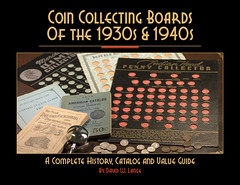 September marks the second anniversary of the publication of my book Coin Collecting Boards of the 1930s & 1940s---A Complete History, Catalog and Value Guide. In celebration, I'm reducing the price to just $29.95 (plus $5 shipping), a savings of $10 off the list price of $39.95. This sale will last through the end of the year, so now's a great time to pick up a second copy. You can preserve the fresh copy for your library, while using the old one to enter updates, notes, etc.
September marks the second anniversary of the publication of my book Coin Collecting Boards of the 1930s & 1940s---A Complete History, Catalog and Value Guide. In celebration, I'm reducing the price to just $29.95 (plus $5 shipping), a savings of $10 off the list price of $39.95. This sale will last through the end of the year, so now's a great time to pick up a second copy. You can preserve the fresh copy for your library, while using the old one to enter updates, notes, etc.
David W. Lange
POB 110022
Lakewood Ranch, FL 34211
941-586-8670
For more information, see: www.coincollectingboards.net
DAVID SKLOW NUMISMATIC LITERATURE AUCTION SALE #8 CATALOG IS ONLINE
October 3, 2009, David Sklow-Fine Numismatic Books will close their 8th auction.
Catalogs available by request; Send inquiries to: David Sklow-Fine Numismatic Books, P. O. Box 6321, Colorado Springs, CO 80934. Telephone: (719)-302-5686; Fax: (719)-302-4933; Email: numismaticbooks@aol.com.
The catalog is currently accessible on-line: www.finenumismaticbooks.com Bids will be accepted by, telephone, fax, email and regular mail. Several sale highlights: Selections from the Myron Xenos Personal Library; and many other consignors.
Lot-650- Cannon, James G. CLEARING HOUSE LOAN CERTIFICATES AND SUBSTITUTES FOR MONEY USED DURING THE PANIC OF 1907: WITH SUGGESTIONS FOR AN EMERGENCY CURRENCY BASED UPON SUCH LOAN CERTIFICATES. New York, 1910. 31pp. 19 plates. Blue cloth covers, original card cover laid on front cloth.
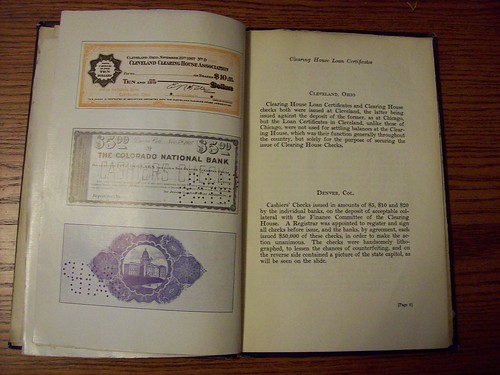
A very rare work; first recognized appearance was in the John J. Ford, Jr. Library sale by G.F. Kolbe lot 234; the author was the Vice-President of the Fourth National Bank of the City of New York; the work is organized alphabetically by city and state, with nineteen color plates depicting clearing house certificates with descriptive write ups on facing pages; ex: Kansas City Public Library with their ornate book plate on the front pastedown, numerous library markings throughout the work; Ex: Libris Melvin and George Fuld Library with their book plate on the front endpaper; library cloth binding with wear at edges and spine, front two endpapers detaching; inside hinges cracking; some tape reinforcement at several signatures; a very scarce work; wonderful plates of the certificates! Not listed in Davis or Stefanelli: Ex: Library. (250.00)
Consignments are now being accepted for all future sales.
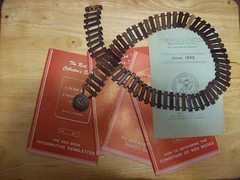 Lot 822 of the sale is a rare item of American Numismatic Association convention material - an
annual convention hanging medal with seventy-one different year bars attached, beginning with Chicago 1893, Buffalo 1901, St. Louis 1904, Philadelphia 1908 and Montreal 1909.
-Editor
Lot 822 of the sale is a rare item of American Numismatic Association convention material - an
annual convention hanging medal with seventy-one different year bars attached, beginning with Chicago 1893, Buffalo 1901, St. Louis 1904, Philadelphia 1908 and Montreal 1909.
-Editor
To view the catalog, see: www.finenumismaticbooks.com
WHY DO SO MANY COIN COLLECTORS REFUSE TO BUY THE BOOKS?
Ray Williams writes:
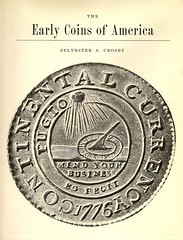 A week ago I got a call from my local club (Trenton Numismatic Club) president asking me what my presentation was to be that evening. This was his way of informing me that I was the guest speaker in a few hours...
A week ago I got a call from my local club (Trenton Numismatic Club) president asking me what my presentation was to be that evening. This was his way of informing me that I was the guest speaker in a few hours...
Every time I talk at coin clubs, the topic is always related to colonial numismatics. Being asked a few hours before the meeting and having no time to prepare, I decided to talk about forming a numismatic library. The only books I had to share were colonial in nature. But the talk was well received and if anyone should be inspired to purchase a book, I'll consider the talk a success.
I have always been astonished that collectors will spend thousands on their coins but will not invest $50 for a book! I fail to see their logic. Hobby enjoyment is increased a hundred fold when you can learn the history about what you're collecting. Also, the informed collector is more likely to make wise purchases.
I showed the club an original Crosby and an original Maris - books that would normally be purchased by bibliophiles as they are collectible in their own right. Then I showed the modern reprints, which were just as good to use for learning, and a lot less expensive. I hope that some of those collectors will have been inspired to start or add to their libraries, but even if they don't, I had a good time that evening and didn't catch anyone snoring.
REVIEWERS SOUGHT FOR MACDONALD'S OVERSTRUCK GREEK COINS
Dennis Tucker of Whitman Publications writes:
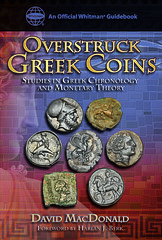 I'd like to extend a request to the readers of The E-Sylum: if someone is interested in reviewing David MacDonald's new book, Overstruck Greek Coins: Studies in Greek Chronology and Monetary Theory, I have an advance review copy I can send along.
I'd like to extend a request to the readers of The E-Sylum: if someone is interested in reviewing David MacDonald's new book, Overstruck Greek Coins: Studies in Greek Chronology and Monetary Theory, I have an advance review copy I can send along.
To read the earlier E-Sylum article, see: NEW BOOK: OVERSTRUCK GREEK COINS BY DAVID MACDONALD (www.coinbooks.org/esylum_v12n34a03.html)
SURVEY: HICKCOX'S HISTORICAL ACCOUNT OF AMERICAN COINAGE
Roger Siboni writes:
George Kolbe, Dan Hamelberg and I are doing some research as to the differences between Large and Small Format versions of Hickcox, Historical Account of American Coinage. I was wondering whether we could ask our subscribership if anyone owns a Small or Regular Format size Hickcox that either has an 1804 Dollar printed on the back of the last page facing the Plates or has a Hickcox with a border around the "Rosa" Plate 5. All other Plates should have borders.
I can be reached at novacaesarea@yahoo.com. Thanks!
This rare and important 1858 work was groundbreaking in its scope of coverage of U.S. coinage. I've forwarded information on my copy to Roger. My copy does NOT have an 1804 Dollar printed on the back of the last page facing the Plates, nor does it have a border on Plate 5.
If you have a copy in your library, please participate in the survey. -Editor
THE BOOK BAZARRE
UNIVERSITY OF MICHIGAN AND AMAZON.COM PRINTING OUT-OF-COPYRIGHT BOOKS
David Ganz writes:
The University of Michigan has teamed up with Amazon and is reprinting out-of-copyright books. I just bought a 1907 U.S. Mint report for under $40 - I'd been looking for a copy for five years. I also bought 1894, 1898 and 1899-1900 (two volumes in one) reprints of The Numismatist. These are all paperbound high quality reproductions and, wow, my set of The Numismatist just got a lot closer to completion (my want list was 1894-1904 except for 1903).
Have other E-Sylum readers tried this service? What do you think of the quality of the printed books? What about the selection of available titles? -Editor
2009 ANS COAC: AUGUSTUS SAINT-GAUDENS AND HIS NUMISMATIC LEGACY
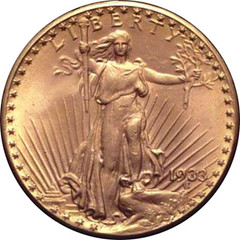 Stack Family Coinage of the Americas Conference: Augustus Saint-Gaudens and His Numismatic Legacy
Stack Family Coinage of the Americas Conference: Augustus Saint-Gaudens and His Numismatic Legacy
Saturday, October 10th, 2009
10am-5pm
This COAC symposium will feature lectures by Saint-Gaudens experts, study sessions of Saint-Gaudens ANS and loan items, and a guided tour of the Saint-Gaudens exhibition at the Metropolitan Museum of Art. Participants are encouraged to bring questions and items for a show and tell session. A boxed lunch will be included.
Please also note that October 8th & 9th, the Metropolitan Museum of Art will be holding a symposium and various tours in conjunction with their exhibit Augustus Saint-Gaudens in The Metropolitan Museum of Art. For more information on the Met programs, visit http://www.metmuseum.org or call 212-535-7710.
"The Lion's Pride: Collecting America's Best Sculptor" Roger Burdette Author, /Renaissance of American Coinage/
"From Imagination to Image: Saint-Gaudens' Plaster Studies for Coins" Henry J. Duffy Augustus Saint-Gaudens Historical Site
"Saint-Gaudens at the American Numismatic Society: A Collection Survey." Robert W. Hoge American Numismatic Society
"Augustus Saint-Gaudens and Charles Barber: Unbounded Egos – Unbounded Conflict" Michael Moran Author, /Striking Change: The Great Artistic Collaboration of Theodore Roosevelt and Augustus Saint-Gaudens/
Collection Viewing: Participants' "Show and Tell" and items from the ANS Museum
Optional: 6pm Guided tour of Augustus Saint-Gaudens in the Metropolitan Museum of Art exhibition with Saint-Gaudens experts
ANS Member Price: $125
Non-member Price: $160
Registration and pre-payment required. Checks should be payable to American Numismatic Society and can be mailed to the address below. Please make note of any dietary restrictions for lunch.
Megan Fenselau
Membership Office
American Numismatic Society
75 Varick St. Floor 11
New York, NY 10013
(212) 571-4470 ext 117
membership@numismatics.org
For more information, see: Augustus Saint-Gaudens and His Numismatic Legacy (www.numismatics.org/NewsEvents/ASGProgram)
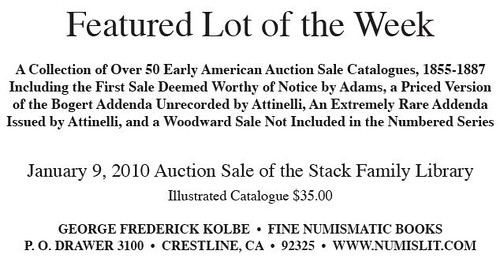
THE NATIONAL SCULPTURE SOCIETY IS THE ANS' NEW NEIGHBOR
The National Sculpture Society has moved. Why is this news in the numismatic field? Well, America's most prestigious sculpture organization has moved next door to America's most prestigious numismatic organization.
They both share the eleventh floor of the block-square building at the corner of Varick and Canal streets in New York City's lower Manhattan. They are also sharing some facilities as well. For its' temporary stay as a new neighbor, NSS has placed all its library and archives in storage. They are using the ANS library, and, according to the NSS press release, "ANS has been very generous in allowing NSS access to their library, conference room and common office areas."
The sculpture organization also states the location is ideal for them as it is within walking distance of the Soho and Chelsea art galleries. It is also within hailing distance of its new permanent home on Mercer Street. (Estimated time of occupancy for that permanent home still undetermined.)
A permanent home for NSS is a 100-year-old-dream of its members. I remember once in the early 1970s I was driving into Manhattan with Bob Weinman as a passenger and driving down the east side of Central Park he pointed out one building near the north end. "We tried to buy that building as a permanent home for the Society," he told me. It had been a never-ending search. I am glad to learn it is close to reality.
The National Sculpture Society and ANS have had a close relationship for nearly ninety years. This came about by the ANS awarding the J. Sanford Saltus medal to sculptors for "outstanding achievement in the art of the medal." Adolph Weinman created the Saltus Medal in 1919 and it was first awarded by ANS to James Earle Fraser that year. (Recognize those names, coin collectors?)
Well, the ANS awarded that Saltus Medal the next year to Adolph Weinman. Yes, he received the medal he created! A not uncommon practice among sculptors, as I can name Abram Belskie among others who were awarded their own medal.
What about all those Saltus Medal recipients over the years? Well for the next sixty years they were all members of the National Sculpture Society. And with the award, the award medal, the ANS wisely made the recipient a life fellow member of the numismatic society. That brought the two organizations close together, in artistic interest, as well now as physical closeness.
The 27 recipients in that sixty-year-period have included the top names in coin creation as well as medal creation. Every one of which were NSS members! In addition to Fraser and Weinman, there were Brenner, Flanagan, MacNeil, Laura Fraser, de Francisci as American coin artists, plus a handful more who created commemorative coins.
Thus American artists were honored with this coveted medal award. The award was not bestowed every year, and it began to slow in the 1970s -- only three awarded that decade -- so the Society began to widen their net and began awarding the American Saltus Medal to foreign artists. A dozen have been so named since Guido Veroi received it first in 1983.
So NSS and ANS have a symbiotic relationship, and now, at least temporarily, both huddled together on the eleventh floor of the Canal and Varick building. I believe this closeness had a modern thrust when Allan Stahl, then a curator at ANS, was named a Councilor to the NSS in 1991.
You can view a list of the J. Sanford Saltus winners at: http://en.wikipedia.org/wiki/List_of_Saltus_Award_winners
ARBITRATOR ORDERS FORMER EXECUTIVE DIRECTOR TO PAY ANA $53,500
Christopher Cipoletti, who was ousted as executive director of the American Numismatic Association, has been ordered to pay $53,500 in arbitration fees and costs to the ANA.
Cipoletti, who was first placed on administrative leave and then fired "for cause" by the ANA board of governors, suffered a complete loss when an arbitrator ruled he breached his fiduciary duty to the organization, double-billed the ANA and private clients, and failed to properly account for his time, spending over 800 hours (the equivalent of 100 days) on non-ANA matters.
The arbitrator, Colorado attorney Kathryn E. Miller, dismissed his claim against the ANA on May 27 and ruled Cipoletti was entitled to no further payments under his employment agreement.
The arbitrator made the requisite finding of bad faith.
Damning his actions, the arbitrator found Cipoletti has been "stubbornly litigious and disrespectful of truth and accuracy."
In summary, the arbitrator's May 27 decision wrote, "Overall, the Claimant's conduct constitutes a breach of his fiduciary duty to the ANA. I have certainly wondered about Claimant's motive for his behavior in this matter. But ultimately, it doesn't matter why. It only matters whether his misconduct was knowing and intentional. I believe that it was. The fact that Claimant paid back the money does not change the outcome. Lawyers are not entitled to use their clients' money until caught. Lawyers are in a position of trust and clients have the absolute right to expect that, even without questions or complaints from the client, their lawyer is being fair and honest with them, and that the lawyer will resolve all doubt in favor of the client. Claimant [Cipoletti]failed to do this."
And so one of several legal gifts in the form of lawsuits left behind by the abrupt departure of Cipoletti is resolved. Where the rest go remain to be seen.
To read the complete article, see: Cipoletti ordered to pay ANA $53,500 (numismaticnews.net/article/Cipoletti_ordered_to_pay_ANA_53500/)
MORE ON DUTCH LION DOLLARS IN COLONIAL AMERICA
Continuing the dialogue on Lion Dollars in the Americas Joe Lasser writes:
On the continuing saga of the Lion Dollar mints. In my thirty years of collecting the coins that circulated in pre-Federal America, I have never heard of nor come across a Lion Dollar minted in Mexico.
Production of such a coin would make no sense. Keep in mind that the mints of Latin America were private concessions licensed from the King until the 1750's and the King was interested in his 20% participation in each mint and had two sets of supervisors watching mint output ; so it would be totally improbable that a mint would produce an unauthorized coin.
Also, don't forget that it was a "bullion world" where the customary denomination used in large scale commerce was the approximately one ounce silver piece which was known as a dollar, thaler,piece of eight,crown, ecu, etc, etc, and it would not be logical for a mint (Mexico) , to produce a less prominent trade coin than the most used-- standard trade coin-- the piece of eight.
Yes, as I said a few weeks ago, imitation Lion Dollars were produced in Europe, most prominently in Italy and Germany, for use in the Mediterranean and Baltic trade where Dutch merchants had very active commerce --with Lion Dollars common in these areas -- and if a merchant had a fleet that was ready to sail -- and he needed coins for trade but had no Lion Dollars, he would simply go to a local mint or a goldsmith who had the capability -- and have some imitations made -- in the proper weight and fineness. No one was injured. There was no fraud. Both sellers and buyers would be satisfied.
Finally, please read Mr. Hallman's and Mr. Marotta's citations carefully. They very clearly indicate that the silver in Mr.Hallman's Lion Dollar and Mr. Marotta's Philips Dollar was Mexican; but not that these coins were minted in Mexico.
THE BOOK BAZARRE
MORE ON ANNIVERSARY TERMINOLOGY
A couple weeks ago I asked:
Are there any medals for a bicenquinquagenary celebration? How many years does that mouthful of a word represent?
Last week Dick Johnson wrote:
Decoding 'bicenquinquagenary' is easy. Two hundred years can be either "bicentennial" or "bicentenary." Break apart either one and insert in the middle the decade and the year:
Thus 'BICENQUINQUAGENARY becomes 'BICEN - QUIN - QUAG - ENARY.
BICEN - 200 years.
QUIN - 40 years.
QUAG - 5 years.
ENARY - anniversary.
I added:
I'd like to know how "quin" gets to 40 and "quag" gets to 5. You call the answer "precise", by which I guess you mean detailed, but the question is whether it's correct.
You can check http://arts.cuhk.edu.hk/Lexis/Latin/ to see that "quinquaginta" is Latin for 50, and the "g" is part of the suffix for ten-fold, as in words like octogenarian or Septuagint.
Ron Abler writes:
I see a delightful debate in the making here. And it is not often that I ever disagree with Dick Johnson; let alone with any confidence. To support my contention that bicenquinquagenary refers to the 250th anniversary, I offer the following Wikipedia definition: "Semiquincentennial - 250 years. Variation: Bicenquinquagenary was used by Princeton University in 1996, and by Washington and Lee University in 1999."
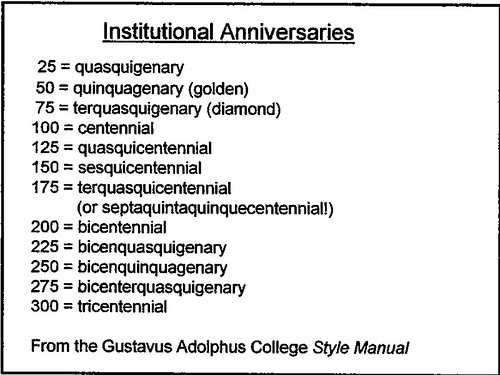
The word is also specifically defined in the Gustavus Adolphus College Style Guide, from which I excerpted the above image. Also, the Latin word for "fiftieth" is "quinquagesima." And the day a "quin" of anything refers to four instead of five is the day my dog becomes a quinaped.
I found the same references on the internet earlier, but hadn't had time to comment. We all know that Wikipedia is no authority, although it can be a useful starting point. We already knew of the Princeton University use of the word. But when I searched further I found a lot of redundant and circular references - one web page citing another web page which cited a third web page, but nothing linked to anything more authoritative than the Gustavus Adolphus College Style Guide.
So I'm still not fully convinced, but there does seem to be a consensus among our E-Sylum respondents that 'bicenquinquagenary' means a 250-year anniversary. -Editor
MORE ON SILVER DOLLAR SMITH
I read the article about Silver Dollar Smith, and thought the following information I have gathered might help clarify a few things.
Charles Smith (1843-1899), was a famed New York saloon owner nicknamed Silver Dollar Smith because of the 2,400 silver dollars used as a studded inlay in his saloon's walls, lights, counter and another 400 silver Trade Dollars embedded in the cement between the marble blocks of the floor, and a $20 Gold piece in the center of the floor. According to the New York Times those silver dollars paved in the floor were worn smooth as blanks by heavy traffic. In 1902, three years after his death, his widow and son "Half Dollar Smith" ordered the silver dollars extracted from the floor by a stonemason after customers had begun stealing them.
German born as Charles or Karl Finkelstein, or, Charles Solomon, or Charles Goldschmidt, or Charles Zabolowskey, etc., was a Jewish gangster, who legally changed his name to Charles J. Smith. He was an alderman in New York, but was a also publicly known as a key member of the Jewish gangsters of Tammany Hall together with Max Hochstim and Martin Engel, and his saloon bouncer Monk Eastman.
Smith was married in August 1873. About 1884 or 1885, he was convicted on the charge of bribery by the Reform Club. In October 1888 he was arrested for assaulting Charles Dandelion. In 1889, he gouged out the eye of a man and assaulted a saloon-keeper named Frank Wolf. In 1891 he was accused for extortion and corruption in the Senator Lexlow trial when he and Hochstim and Engel attempted to destroy Mrs. Urchittel.
In August 1894 he was charged with extortion for charging $25 to supply a bondsman as a striker for the Shirtmakers' Union. In December 1894 he was arrested for stabbing a fellow saloon owner August J. Gloistein. Despite all of his crimes he used to give out free matzah during Passover to all the poor Jews in New York, and in his will he wished to leave funds to buy Christmas gifts for poor children.
To read the earlier E-Sylum article, see: MYSTERIOUS LEDGER SIX NINE FOUR: SILVER DOLLAR SMITH (www.coinbooks.org/esylum_v12n35a10.html)
QUERY: NICARAGUAN BANKNOTE BATHROOM WALLPAPER
Last week, in discussing "Silver Dollar Smith's" saloon, Tom Kays wrote:
Can E-Sylum readers suggest further examples of garish architecture/home decoration that one can visit today, daring visitors to look in any direction without seeing money?
Alan Luedeking writes:
I heard once that one of the people that fled Nicaragua with Anastasio Somoza at the end of the revolution in 1979 carried off a huge fortune in Nicaraguan banknotes looted from the Central Bank. When the Sandinistas took power one of the first things they did was to demonetize all the currency, allowing just a few days for the public to redeem the cash in their possession. They then issued their own revolutionary currency, starting the wild inflationary spiral that lasted for nearly twenty years.
The man thus found himself with a vast amount of now worthless paper money and proceeded to wallpaper the bathrooms of his house in Miami with it. I always wanted to see it but never got the chance. But I did hear about it from people who said they had. Nevertheless, the story may be apocryphal...
VOCABULARY QUERY: COUNTERSTAMP AND COUNTERMARK
I am looking for a Numismatic definition of the terms CounterStamp, CounterMark. IMHO there are two types of Marks - one which is punched at a fixed location on coin design, and other which is puched randomly on coin.
In a coin discussion forum http://www.coincommunity.com/forum/topic.asp?ARCHIVE=true&TOPIC_ID=27547
I found the following definitions
COUNTERSTAMP- an official punch mark to signify legal tender status of a foreign coin or change in value of a domestic coin [eg, Spanish dollars counterstamped with image of George III]
COUNTERMARK- private punch mark used as advertising or as a sort of merchant coupon to keep coinage in local circulation in times of coin shortages [eg, 18th century English silver]
This defines the difference as between Government and Private.
DAVID GANZ' LONDON DIARY
There's a special exhibition on political, satirical medals, old and modern. Entitled "Medals of Dishonor", it is a major display in room 90 on the 4th level, not too far from the sit down restaurant. More than showing a Karl Goetz medal, they have sketches of portions of the artwork and ephemera. Even Kathy liked it and called it fascinating.
Goetz, of course, is a satirical medallist (1875-1950) who is famous for his Sinking of the Lusitania, a propaganda piece that suggests that Germans had advance knowledge of the sinking on an unarmed passenger ship.
Philip Atwood and Felicity Powell authored a 136 page full color book with the same title as the exhibit (British Museum, 2009, £17). From the early 1600'sonward, medals were used for satiric purposes. The exhibit thoughtfully includes some 2008 medals created as propaganda satire (think Iraq, Saddam Hussein, Tony Blair's involvement as prime minister, and some anti-American themes. The content of the themes may be disturbing, but the composition of the medals is quite real. Most interesting is the use of drawings of the artist, sketches of components of the medals, and background commentary.
We then made our way through Greek and Roman (ancient) galleries where, remarkably, Greco-Roman coinage from the Museum's world renowned cabinet is fully integrated into the display. That means, for example, that of (say) a hundred odd objects in a room, three to a half dozen numismatic items are displayed with appropriate explanations.
To see statues, heads and other objects together with coinage that illustrates the same thing is remarkable. It also shows that a museum can use numismatic items – something that many American museums have yet to learn.
We ambled through the museum towards room 68, the history of money exhibit sponsored by Hong Kong Shanghai Bank (HKSB), an exclusive and inclusive exhibit that starts with primitive money (cocoa beans, cowrie shells, a small two foot diameter example of Yap stone money), then various examples of coins, tokens, medals and paper money over a 2,700 year span – integrated with an engraving reduction machine, a weighing machine and coining presses.
HOW PEOPLE IN 1842 USED COUNTERFEIT DETECTORS
Travelers'' accounts often reveal their encounters and problems with the monies in circulation wherever they happen to set foot. This extract is from Sir Charles Lyell (1797-1875), Travels in North America, Canada, and Nova Scotia with Geological Observations (London: J. Murray, 1855), pp. 215-216.
His remarks document his first-hand experience of an earlier perilous moment in U.S. banking history. Alas, the Counterfeit Detector in question is not further identified, nor are the notes in question or the names of the four failed banks. I have transcribed the pages verbatim
Philadelphia, January to March, 1842
Wishing to borrow some books at a circulating library, I presented several dollar notes as a deposit. At home there might have been a ringing of coin upon the counter, to ascertain whether it was true or counterfeit; here the shopwoman referred to a small pamphlet, re-edited "semi-monthly," called a "Detector," and containing an interminable list of banks in all parts of the Union, with information as to their present condition, whether solvent or not, and whether paying in specie, and adding a description of "spurious notes."
After a slight hesitation, the perplexed librarian shook her head, and declaring her belief that my notes were as good as any others, said, if I would promise to take them back again on my return, and pay her in cash, I might have the volumes.
It often happened that when we offered to buy articles of small value in shops, or fruit in the market, the venders [sic] declined to have any dealings with us, unless we paid in specie. They remarked that their change might in a few days be worth more than our paper. Many farmers and gardeners are ceasing to bring their produce to market, although the crops are very abundant, and prices are rising higher and higher, as if the city was besieged.
My American friends, anxious that I should not be a loser, examined all my dollar notes, and persuaded me, before I set out on my travels, to convert them into gold, at a discount of eight per cent. In less than four weeks after this transaction, there was a general return to cash payments, and the four banks by which the greater part of my paper had been issued, all failed.
QUERY: INFORMATION ON MARDI GRAS DOUBLOONS SOUGHT
Dave Welsh of classicalcoins.com writes:
I would appreciate it very much if someone on this list could provide information as to the manufacture and collecting of the modern day jetons that are distributed as "doubloons" during Mardi Gras parades.
Back in our April 9, 2006 issue, numismatic literature dealer Richard Stockley wrote:
I sell a book called "Doubloons Commemorative Medals" by Jerry Ledet Sr. I don't know if it is updated every year - mine is a 1994 edition. It is basically a listing, not illustrated, of the doubloons along with a couple of other items.
QUERY: 1959 GOLD STATEHOOD MEDALS FOR ALASKA & HAWAII
Bob Rhue writes:
I have a longstanding question re the original mintage of the 1959 Alaska & Hawaii official statehood medals struck in Gold:
These large gold medals weigh 218 grams, (7 oz), of 900 fine gold.
I have long wondered if anyone has any solid information on = The number of each of these which were actually struck. I've heard or Read differing numbers over the years, from various sources, that 100 of each were struck; that 100 of each were 'authorized='; that 50 of each Were struck; or that 100 Alaska's were struck and 50 or 75 Hawaii's were struck.
Without question an unknown number of both were melted in the 1979-80 gold run up. And from personal observation over the years the Hawaii piece definitely comes up less often than the Alaska one.
All of these issues struck in gold are serially numbered on the edge somewhere between 1 and 100. That said, if less than 100 were struck of both or of either issue, is there a known or recorded number sequence?
I've read for instance that one of the states' issue is numbered from 1 to 50 and the other from 51 to 100. That theory is categorically not true however, as I have observed issues from both states, numbered both above and below #50. (And there was in a recent Heritage auction a pair - one of each state both serially numbered 26. (In addition to the serial number the edge is also stamped 'Medallic Art Co. NY 900 Fine')
I understand that Dick Johnson was with Medallic Art Co. of New York (MACO), when MACO issued these medals in 1959. Thanks for any clarification that he or anyone else can shed on this matter.
Born in 1958, I'm 51 years old. But any mention of Alaska and Hawaii statehood makes me feel positively ancient, because when I was born, there were only 48 states in the union. Someday I'll relish telling that to my grandchildren, but right now it gives me the heebie-jeebies.
Anyhow, Bob poses an interesting question. Can anyone help? -Editor
COURTESY IN NUMISMATIC RESEARCH
Russ Sears writes:
I noted Sheldon Banoff's cataloguing of town anniversary medals and the fact that Wendell's of Minneapolis was a prime maker of them. Earlier this year, I was researching a 1972 medal which commemorated the 175th anniversary of the incorporation of the City of Baltimore and the 175th anniversary of the launching of the U. S. F. Constellation. This is not the U. S. Mint medal which was also made in 1972.
I sent a friendly email to the president of Wendell's asking about any information they might have about the medal after being referred to them by someone involved with selling custom made medals around that time. In my email, I mentioned that any information provided would be credited to Wendell's.
I did not receive any reply to my request. My article was forwarded to the Editor of the Maryland Token and Medal Society Journal with the information I found and included my request to Wendell's which resulted in no response.
Perhaps I am a bit old-fashioned, but if I ran a company which deals/dealt with medal sellers and collectors, I would respond, even if it was that I didn't have any information.
THE U. S. FRIGATE CONSTELLATION MEDALS
There has been some documentation about U. S. F. Constellation medals made in the early 1960's using, in part, copper from the spikes of the ship. The medals made for the Constellation by the U. S. Mint in 1972 have also been documented because the mint has good records of what they make. There has not been information for the other 1972 medal.


Our illustrated medals were made to celebrate the 175th anniversary of both the U. S. F. Constellation and the incorporation of the City of Baltimore, 1797 - 1972. Over the years, I wondered who issued the medals, for what purpose they were issued, and how many were made. At a Maryland TAMS meeting, Richard Kaminski loaned me a booklet from Southwest Medallion, Designers of Commemorative Medallions & Art.
The booklet from Southwest Medallion included what appeared to be press releases or advertisements for various commemorative medallions and information promoting issuing a medallion
When I called Southwest Medallion, Mr. Leo B. Comallie who owned the company (it is no longer in operation) advised me that he did not remember a ship medal. In conversation with him, we discussed that he did marketing, customer service and design of the medal to be made. The actual striking of the medal was likely done by Wendells of Minneapolis, Minnesota. It appears that Wendells struck the medals which were available to the public for free based on making a donation to the Constellation
According to the advertisement, which looks like it may have appeared in Coin World or Numismatic News, the following were made and available for distribution:
| 25,000 | Bronze | Donation of $ 3.00 |
| 100 serial numbered | Silver | Donation of $ 20.00 |
| 10 serial numbered | 24 karat gold | Donation of $ 250 |
One serial numbered platinum was sold by sealed bid to the highest bidder, opened by the mayor of Baltimore on November 1.
Months passed since we sent an email to the president of Wendells with questions about the medal. Unfortunately we did not receive an answer. We wanted to confirm that the gold medal was actually 24 karat (pure gold) and requested the content of the platinum piece. So, even though we have uncovered some information, there are still unanswered questions.
THE BOOK BAZARRE
CHINESE COUNTERFEITING OF RARE COINS
Kudos to Beth Deisher for her full page editorial in the September 7th issue of Coin World. While this is an update of a series of articles in three December 2008 Coin World issues on this devastating situation, this is so important it bears constant repeating.
Beth justifiably devoted twice the space of her normal weekly editorials. She reveals there are at "least 100 factories operate[ing] in China whose sole business is producing counterfeits of coins and paper money of virtually every country that issues coins and paper money."
Let that statement sink in your mind. That is a tremendous amount of phony production. The editor speculated this "has the potential to destroy the coin collector market in the United States and other countries as well."
Then how do all those counterfeit collectors' items move into the channels that ultimately end in collectors' hands? Answer: eBay for the most part. It is more than the Chinese maker selling an item or two to Americans by internet auction. They are now seeking "wholesalers" everywhere to sell vast quantities the phonies to unknowledgeable buyers, often at local flea markets in addition to eBay.
Beth goes on to discuss the four levels of numismatic material they are producing, and the effort of the Canadian government to force eBay to remove Chinese counterfeit offerings. The Canadians had some success with eBay, in contrast to the American government, which has done nothing to halt this practice.
Therefore it is up to the individual collector. What can the individual do? Stop buying all coins and paper money on eBay! EBay officials are hiding their head in the sand and as Beth notes, "eBay has taken no steps to bar their use of its online auction site for their fraudulent practices."
Beth did not go so far as to issue such a moratorium on eBay purchases. But I see no other solution.
Granted, legitimate dealers will be affected, too. But it will serve as notice to both the Chinese and eBay that this is so harmful that the American numismatic community is willing to go to this extent to cut off the flow of their counterfeit productions.
Instead collectors should only buy from numismatic auction houses and legitimate dealers who offer full money-back guarantee if you can prove any item is not genuine and legitimate. But even that may be a problem since so much is already in the numismatic market and the Chinese counterfeits are difficult to detect.
Buyer beware!
KAVAN RATNATUNGA ON SRI LANKA'S NEW COMMEMORATIVE COIN
Longtime E-Sylum reader and contributor Kavan Ratnatunga published an article recently in the Sunday Times of Colombo, Sri Lanka about that country's latest commemorative coin and the Bank's coin distribution practices.
Kavan and I were both regular attendees at the meetings of the Western Pennsylvania Numismatic Society in Pittsburgh, where he worked at Carnegie Mellon University before returning to his native country. He is a life member of the Sri Lanka Numismatic Society and maintains a great web site on Sri Lankan coins at http://lakdiva.org/coins/. -Editor
A commemorative two hundred rupee, frosted proof silver coin was issued by the Central Bank (CBSL) last week, on August 25 to mark the Bicentennial of the Sri Lanka Customs Department. It is the same size of a Rs 2 coin and has 11.9 grams sterling Silverworth currently about Rs 650/-. The face value was probably selected because of 200th Anniversary.

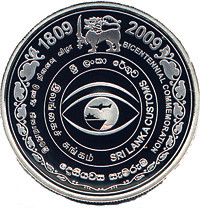
After releasing a 'Notice to the Public' on its website on Friday 21st, CBSL put few large advertisements in the Sunday newspapers stating that a limited issue of 3,000 coins will be issued into circulation and a coin will be sold at a price of Rs. 3000. What CBSL did not say in that advertisement was that most of the issue (2750 I am told) was taken by the Customs Department which requested the coins, and not available to the general public.
When I phoned the CBSL I was told that the coins will be issued after 11 am. I got to the CBSL cash counter sharp at 11 AM and was 2nd in the queue. Another collector had come early. By about 11:15 AM when they started issuing the coin a long queue formed and the 50 coins released that day was over in under half hour, although they sold only one coin to each customer. I understand from a collector friend who went on the next day that only six coins were issued on the 26th, and he was 10th in line and was very disappointed not to get one. There had been quite a uproar when one person had jumped the queue and got one.
It is a pity that the CBSL has created an artificial scarcity of this coin, and have not minted sufficient to meet the coin collector demand of the public both locally and internationally. However this current issue is slightly better than the last when CBSL minted just 100 Frosted Proof coins for the Employment Provident Fund and did not make any of them available to the Public. It is now one of the few modern Lankan coins I don't have in my Coin Collection.
The action of CBSL only aid the coin dealers in Fort. For example the one rupee Air Force coins of which only 2000 were minted and 800 released to the public in 2001 March at Rs 600 was sold out in under one month, and I have heard of a rumour of a hoard of them by an investor. They are now sold by dealers for over Rs 15,000 if available.
To read the complete article, see: The new silver frosted proof coins (http://www.sundaytimes.lk/090830/FinancialTimes/ft19.html)
INDIAN NUMISMATISTS COLLECT 'CANTEEN COINS'
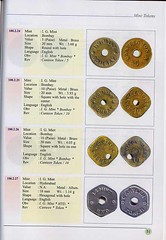 Black, rundown chimneys still stand tall against the eastern sky, telling the story of the rise and fall of the Manchester of the
East. But, they are not the only remnants of the glorious days of Ahmedabad's textile revolution. Amdavadis have found an interesting way to preserve the heritage — coin collectors in the city are preserving and trading in canteen coins used by workers of these closed mills to buy chai. "Canteen coins in my collection are from an era when the city went to sleep with the last siren of textile units and woke up with the first.
Black, rundown chimneys still stand tall against the eastern sky, telling the story of the rise and fall of the Manchester of the
East. But, they are not the only remnants of the glorious days of Ahmedabad's textile revolution. Amdavadis have found an interesting way to preserve the heritage — coin collectors in the city are preserving and trading in canteen coins used by workers of these closed mills to buy chai. "Canteen coins in my collection are from an era when the city went to sleep with the last siren of textile units and woke up with the first.
I have been collecting these for more than 30 years now and have around 600, most of which are from textile mills," says 70-year-old retired IAS officer Praful Thakkar, author of the book 'Collectors' Guide to Indian Canteen Coins'. The coins that got textile workers just a chai or a plate of rice and dal in those days, can now buy you a lunch at a hip restaurant. "There has been a surge in demand of para numismatics coins which include coins from closed textile units, token coins from the Army, mints and other public and private set-ups.
These days, textile canteen coins are sold from anything between Rs 50 and Rs 2,000, depending on its mint quality and the mill it belonged too," says Gujarat Coin Society president Harish Shah. For city-based coin collector Abhay Shah, canteen coins from closed textile units are his priced possession. "I have coins from the period of Sultanates dating back some 2000 years and of different periods. But canteen coins from closed textile units are special. They are a piece of the glorious past of my city and I love to preserve them," says Shah, who has around 100 such canteen coins. The mills introduced these coins following a shortage of smaller coins during late 19th century.
To read the complete article, see:
Boon from Ahmedabad mills: Canteen coins
(timesofindia.indiatimes.com/NEWS/City/Ahmedabad/
Boon-from-Ahmedabad-mills-Canteen-coins/articleshow/4950104.cms)
MYSTERIOUS LEDGER SIX NINE FOUR: TWO-CENT TALE
More from Mysterious Ledger Six Nine Four, a turn-of-the-twentieth century newspaper scrapbook time capsule of odd and curious tales. Here is a story evoking the original "Where's George," Mr. George that is.
TWO-CENT TALE
Coins Have Traveled the Country Over –
Maine Soldiers Stamped Initials on Them at Port Hudson.
There are two [bronze] cents, which bear the mint stamp of 1863, that have traveled over most of this country. Their journeying began when the 25th Maine Regt was encamped before Port Hudson, [Louisiana] in August 1863.
One day Humphrey Pinhorn and Albert George, privates in Co. F received as part of their pay a number of new [bronze] cents which were still bright. Wishing to test the truth of several stories they heard, the two soldiers stamped their initials and the date on two cents and turned them over to the sutler in exchange for goods. The term of enlistment of the members of the regiment expired soon after the fall of Port Hudson, and the two soldiers went back to their homes in East Orrington, [Maine] where they have resided most of the time.
In the summer of 1868 when Mr. George was in Portland as a member of a campaign marching club from eastern Maine, he purchased a daily paper at a newsstand, and received in change, a [bronze] cent, dated 1863 and bearing the initials "H.P." He took the coin back to his friend, who stamped the date "Aug 30, 1868," on the face and sent it going once more.
In February 1869, Mr. George sold some lard to a store in Bangor and took in payment a [bronze] cent marked "A.G. 1863" which was the one he had spent in front of Port Hudson. He stamped it with the new date and passed it along. Nothing more was heard from the coins until the following June, when Mr. Pinhorn received a cent bearing the stamp of "H.P." from a friend in San Francisco who said he had read the story about the wandering coins in a Grand Army paper, and chanced to receive the identical coin soon after. He had taken the liberty to return it to its rightful owner. In October 1871, Mr. George received the "H.P." cent while making change in the post office at Bucksport, Me, and returned it to Mr. Pinhorn, who affixed another date and passed it along again.
The George cent was received by a Grand Army man in Westbrook, Me, in January, 1872, who, knowing the story, mailed it back to its owner. Again it was stamped with a date and sent on its travels. It returned again in July of the same year, having been sent from Dover, Me. While Mr. George was calling at the home of Mr. Pinhorn for the purpose of showing the wandering cent, a meat cart drove up to the door, and in making change for what was purchased, the peddler gave Mr. Pinhorn, the cent that was marked "H.P." By this time the tale of the traveling cent had been published in several newspapers, resulting in having both coins returned as often as once a month.
The owners wishing to avoid publicity as much as possible, both cents were enclosed in an envelope and sent to a man in Detroit, Mich., for the apparent purpose of paying postage on a seed catalog. Several months later Mr. Pinhorn received the "H.P." cent from an old soldier in St. Louis, who had read the newspaper accounts of the experiment and hoped to forward the movement. From then on until early in 1876 the Pinhorn cent was recovered five times, once by mail from Worchester, Mass, twice by friends who had taken it in business transactions, once by Mr. George, who had received it from a friend in Bangor, Me, and once by Mr. Pinhorn himself, who took it at a store in Holden, Me. – Bangor Commercial.
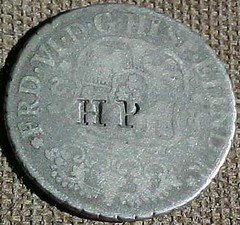
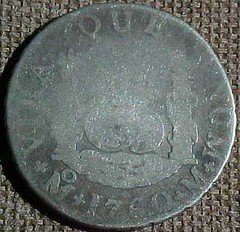
Surprisingly this E-Sylum contributor has an old coin with "H.P." counterstamped on its face. It was found at a civil War site at Malvern Hill. Rather than a copper-nickel cent, it is a well worn Mexican pillar two reales, dated 1760. It might as well be attributed to Humphrey Pinhorn, 25th Maine Regt., or to an unknown Grand Army of the Republic reader "in the school of Humphrey Pinhorn" who wished to set such things in motion. Does anyone know if the 25th Maine Regiment, or their sutler's train passed though Richmond, Virginia with a stop near Malvern Hill, circa 1864?
ANCIENT GREECE: WHEN MONEY WAS NEW
In the ongoing reconstruction of twenty-first century finance, ancient Greece may seem an unlikely place to turn to for guidance. Then again, why not? For it was in the little city-states around the Aegean Sea that coined money first appeared in the seventh century B.C., and, in the sixth century, came into widespread use.
The emergence of this first thoroughly-monetized society in history precipitated two further developments for which the Greeks are much better known – "philosophy," meaning the conception of the cosmos as an impersonal system, and tragedy, or the self divided against kin, nature, the gods themselves.
That's the story according to Richard Seaford, professor of Greek Literature at the University of Exeter, in England. In Money and the Early Greek Mind: Homer, Philosophy, Tragedy, he argued that the invention of money thus sent shockwaves through Greek culture and down the ages to the present day.
When it appeared in 2004, Seaford's book was startling and controversial. Specialists had long supposed that alphabetic literacy, not currency, was the great breakthrough in classical Greece – that, everywhere and always, the text was the thing. But Seaford has since won many of his points. Money clearly mattered to the Greeks, in deep and troubling ways.
Once the basic technological problems were solved, the use of coins spread rapidly. The whys and wherefores of how this happened are intricate and imperfectly understood. But the key to the transition from the use of relatively few coins made of the naturally-occurring but highly-variable gold/silver alloy of electrum to large numbers of coins of refined metal seems to have been the discovery stamped by governments to guarantee their value. Virtually always minted by the state, the new coins were counted, not weighed.
What's really interesting is what happened next, as the Greeks began to grapple with the system they had invented. Money was homogeneous and impersonal, they discovered, abstract and concrete, an end in itself and a means to universal aims, different from everything else. The most unsettling thing about it was the recognition that its possessor could buy his way out of all other (pre-monetary) forms of social relationship, at least in principle: violence, reciprocity, redistribution, kinship, ritual, and so on. No wonder some people would do anything for money!
The recognition that money could dissolve these bonds worried the Greeks. "Hence the focus of much Athenian tragedy on the extreme isolation of the individual – from the gods and even (through killing) from his closest kin," writes Seaford. "I know of no precedent for this in literature, certainly not in the pre-monetary society depicted in Homer." The figure of the tyrant preoccupied Athenian society, he writes: absorbed by money as the means to power, violating the sacred and murdering his kin, never more memorably than in the dénouement of the Oedipus saga in Aeschylus' Seven Against Thebes, in which the king's sons kill each other battling over their inheritance. The words "hero" barely appears in Athenian tragedy, but "tyrant" (turranos) occurs more than 170 times.
The most peculiar novelty of money, Seaford says, was that it was unlimited. As a case in point, he cites Aristophanes' last play, Wealth, almost certainly the earliest surviving text on economics. The whole play revolves the leveling powers of money, but Seaford describes the key exchange: "whereas one can have enough sex, or loaves or music, or honor, cakes or manliness and so on – money is different: if somebody obtains thirteen talents (a lot of money), he is eager for sixteen, and if he obtains sixteen he swears that life is unbearable unless he obtains forty."
To read the complete article, see: Learning from Ancient Greece: When Money Was New (seekingalpha.com/article/159183-learning-from-ancient-greece-when-money-was-new)
THE ASHMOLEAN MUSEUM'S HEBERDEN COIN ROOM
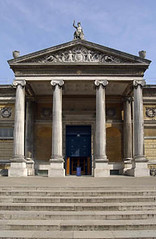 The Heberden Coin Room houses a systematic and comprehensive collection of some three hundred thousand coins and medals. It has an academic staff of seven and is a leading international centre for teaching and research in numismatics and monetary history.
The Heberden Coin Room houses a systematic and comprehensive collection of some three hundred thousand coins and medals. It has an academic staff of seven and is a leading international centre for teaching and research in numismatics and monetary history.
The collection goes back to the seventeenth century, although the Coin Room itself was opened only in 1922. It has been formed by combining the original holdings of the Bodleian Library and the Ashmolean Museum with over sixty former private and college collections.
Since the re-opening of the Museum in late 2009 the Coin Room includes a major new Money Gallery, an environmentally controlled and highly secure Coin Store, a well-appointed Coin Study Room for visitors, and a Seminar Room for numismatic teaching.
The Heberden Coin Room is now one of the leading international coin cabinets, with particular strengths in the fields of Greek, Roman, Celtic, Byzantine, Medieval, Islamic, Indian, and Chinese coinages. It also holds collections of paper money, tokens, jetons, and commemorative and art medals.
The Coin Room enjoys a dual role as a major international cabinet and as a department of the University of Oxford. This fruitful conjunction has helped us to develop the Coin Room into a centre for the teaching of numismatics and monetary history of worldwide significance.
The departmental archives include material relating to the collections formerly in the Bodleian and in the Colleges, as well as to the Ashmolean's own collection. The archives also contain material important for the history of numismatics, including the papers of a number of eminent scholars (for example Sir John Evans, Sir Edward (Stanley) Robinson, Derek Allen, J M F May, and Colin Kraay).
The Coin Library is administered by the Sackler Library. The holdings of books and periodicals may be searched online at http://www.lib.ox.ac.uk/olis/. The Library also contains extensive collections of pamphlets and auction and sales catalogues.
For more information, see: Heberden Coin Room (http://www.ashmolean.org/departments/heberdencoinroom/about/)
FEATURED WEB SITE: MORE MEDALS OF THE WORLD
Hedley Betts writes:
For a fleeting moment, as I perused the index to last week's E-Sylum, I thought my website was the featured site. I eagerly scrolled down to check it out, but it turns out that it was a case of mistaken identity, a different "medals of the world." For another "medals of the world" that features historical and art medals, also a fair selection of books, I invite you to visit: www.medalsoftheworld.com
Guess what? This week's Featured Web site is Hedley Betts' Medals of the World. Although we don't normally feature commercial sites, this one is useful for researchers, with great images of interesting medals, and an archive of images of previously sold items .
Pictured below is an undated (circa 1875) medal by Leonard Charles Wyon of Great Britain - ST. THOMAS'S HOSPITAL MEDICAL SCHOOL, RICHARD MEAD MEDAL.
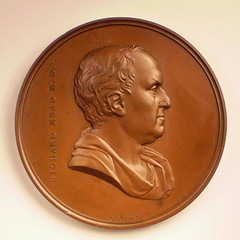
www.medalsoftheworld.com

